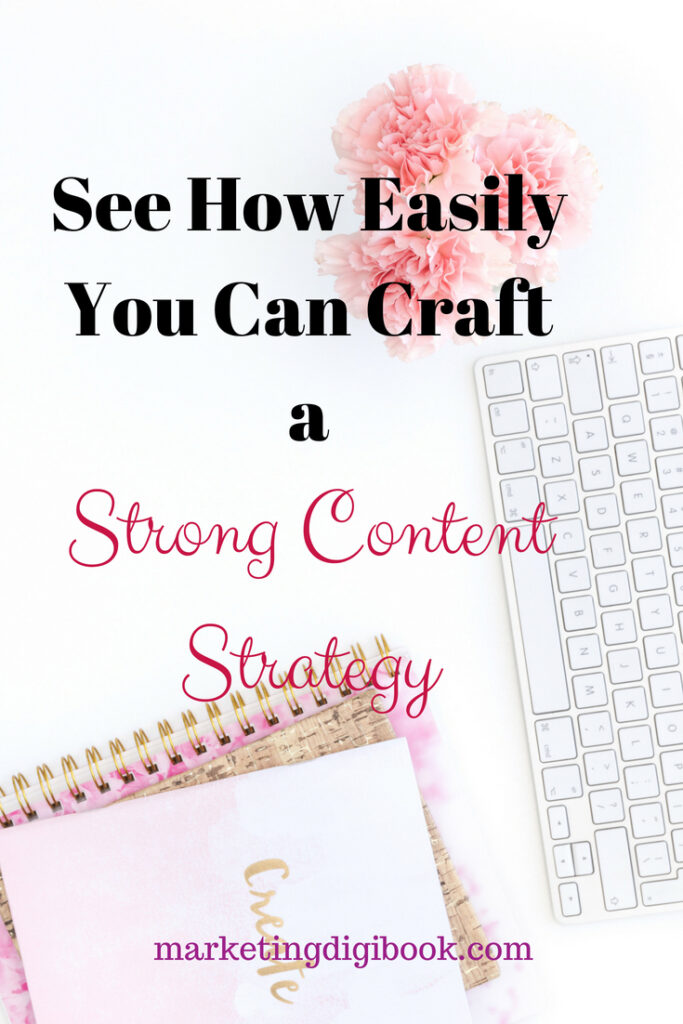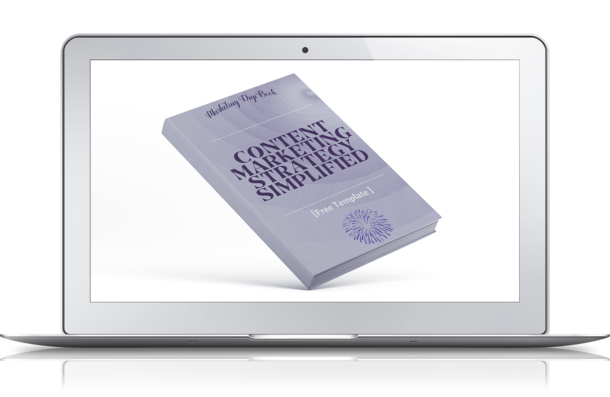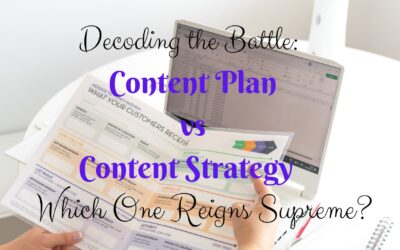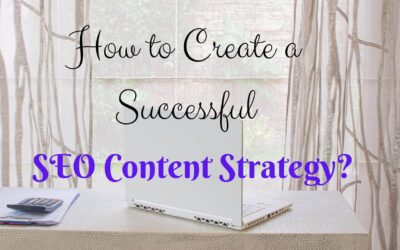The digital content marketing strategy is essentially a blueprint that includes processes, standards, and topics to help you plan, create and publish your content.
The content marketing strategy is the foundation of reaching your business
. It is a sort of magnetic compass that you have to craft on your own measure to show you the way to your objectives. And of course, we are all striving to find the best content strategy that works for our business.
“The essence of strategy is choosing what not to do.” Michael Porter
It’s a guiding line that organizes the marketing teams involved in producing content: writers, editors, SEO specialists, designers, producers, project managers, analysts, etc., identifies the needed tools and channels and provides procedures and workflows. And aligns all the stakeholders involved toward the same goal.
Remember your digital content marketing strategy line needs to be flexible and your team agile. In our ever-changing world, it happens quite often that the situation forecast in January has nothing to do with the reality of May.
Useless to reinforce why you need a content marketing strategy, it’s vital to have a path that leads you toward your goals.
If still in doubt, check on statistics. Less than 7% of B2B and B2C content marketers don’t plan to use a content strategy next year – HubSpot says, CoSchedule found out that a documented strategy is likely to improve your success with 414%. So, judge yourself!
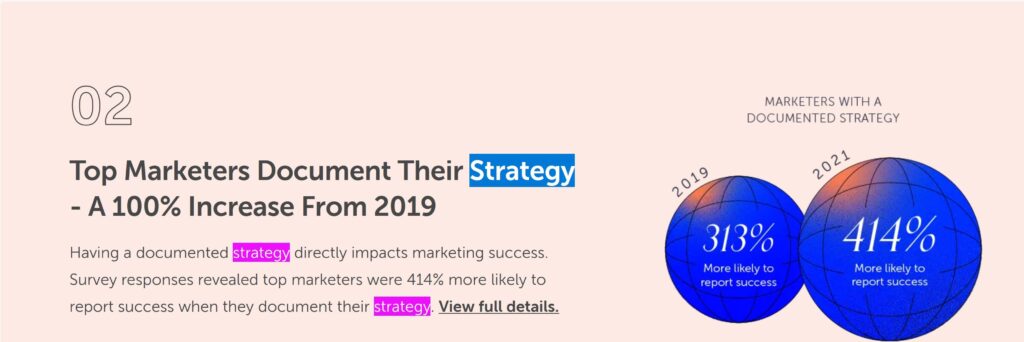
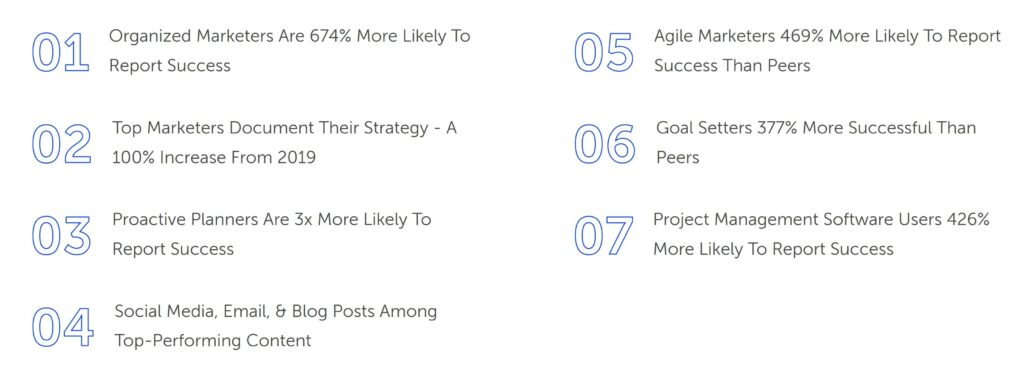
When you need to arrive from point A to point B, you establish in advance a route. This is similar to your business, to achieve the goals you need a route, and that’s the strategy.
A simplified content strategy template that will definitely help you in your endeavors of creating your strategy is to be found if you click the aforementioned link.
A successful content marketing strategy is the ultimate game-changer for your business. Because it’s one of the key things that will give you an edge over your competitors. Investing in it is therefore well worth all the effort.
Audiences have become smarter and more discerning today than ever, they’re looking for value and relevance. Most of them, as time goes by, are becoming media-savvy and can now tell the difference between the noise in traditional advertising and real content that serves their needs. And this is where content marketing is king, it’s what will help you create and deliver the information your audience needs.
What Do You Hope to Gain from Solid Content Marketing Strategy?
a. It’ll Help Establish Trust with Your Audience
People tend to lean towards something that offers them relevance and value. This forms a good basis for trust. By connecting with your customers and giving the answers to their questions through the content you deliver them, you will be building a solid relationship that they can always come back to.
Consistently offer quality content to your audience and find yourself building a good reputation for your brand, which will consequentially attract the trust and loyalty that you need.
b. It’ll Bring Them Back for More
When you offer your audience just the right content, they will get a positive experience. Whenever they visit your site or social pages they will get solutions and this will keep them coming back for more. The positive experience reinforces how they see and feel about your brand.
c. You Gain Authority
Churning out great quality content is your business’s way of flexing your muscles and proving your expertise in your field. When you publish content that solves your audience’s specific issues, your audience will look at you as an expert worth her attention. This will boost your authority and rank your content higher.
d. It Generates Leads
Generating leads is one of the key goals of any marketing campaign and quality content is at its heart. The calls to action become very instrumental in generating leads to your landing page.
e. Boosts Conversion
For most businesses, this is the ultimate goal. And this will be easier if you provide your audience with useful information that they can eventually trust over time. With trust established, and with the right calls to action, the purchasing decision will be in your favor.
Thus, this is a strong relationship between quality, relevance, and offering solutions.
Invest In Your Business
Your Content Strategy Doesn’t Deliver the Expected Results?
Elements of a Strong Content Marketing Strategy
What is a content marketing strategy without the key elements? These are the building block of effective content marketing efforts.
a. Positioning
This can be considered as the manner in which you get your brand out of obscurity by creating awareness about all the solutions you offer to your audience through the aptest platforms thereby amplifying your expertise to a higher position of great reputation.
When you set yourself as an expert in your niche, you’ll have the leeway to set higher rates for yourself and set yourself up for greater opportunities. This means being in each place where your audience looks for solutions to their problems. When you position yourself on multiple platforms sharing your expertise, you’ll build higher confidence with your audience.
b. Value Proposition
When your audience’s needs meet your solutions in perfect positioning, magic happens. However, achieving this requires navigating through clear communication, true perception, and delivering on your brand promise.
And this is where a good value proposition comes to play. It’s the baseline promise to your audience. A clear expression of what they stand to gain by purchasing your product or service. It’s about the thing that makes you unique and makes you stand out from your competitors to the advantage of your customers. Identify it and offer it.
c. Business Case
The next important element in online content marketing strategy is about driving your brand forward. This will require clearly defining your goals (read below) in order to see how creating an inbound content marketing strategy will get you closer to them.
Knowing your goals will lead you to pick the resources to invest in in order to achieve your desired results. It will also help you have a clearer picture of the costs, benefits as well as risks of implementing your content marketing efforts.
d. Your Strategic Plan
This final element is meant to help plan every step that will support you in reaching your overall goals and how you’re going to measure them. You have to insert in a strategy the platforms you want to use and also the methods you will use to promote the content.
It’s a top priority to also consider the most appealing content type for your target audience. Often times a mixture of videos, blog posts or infographics would be a great approach.
To facilitate your task check the digital content marketing strategy template below, which I created especially to help businesses streamline their strategy creation efforts.
Now, let’s start and identify the core pillars that are sustaining your website content strategy:
Effectively How to Create a Content Marketing Strategy? A Content Strategy Outline
Pillar 1: Results of Content Audit
If you are not starting from scratch, before committing to the creation of your digital content strategy for the next year, an audit and revision of the content you produced last year are compulsory.
· Inventorize your content. First, you need a quantitative evaluation of the content you already have. Where is it published? How many pieces are published? In which format? Which of them show up on the first page of search engines? Collect in an inventory list with data like link, author, publishing date, last update, keywords, etc.
· Content audit. This is a qualitative evaluation of the content you listed in the content inventory list. Which is the quality level of this content? Does it meet your actual quality standards? Is it in line with your brand? Does it answer properly to your audience’s pain points? Which pieces of content generated the most traffic and why? Which is the bounce rate? But the dwelling time? How are the social shares? Is the actual content converting according to targets? Search for explanations and answers to these questions.
· Competitor analysis. By examining competitors’ well-performing pages, you can understand which valuable pieces may be missing on your website. Use the SE Ranking SEO competition tool to investigate your rivals’ organic performance, find out which keywords work best for product or landing pages, and which are perfect for audience educational purposes. Also, make sure to check if there are any SERP features for queries you are going to target (like the “people also ask” section, featured snippets, or site links) and optimize your content for them as well.
· Identify the content gap. Search for topics that are not covered by your content and they should be.

Visuals are the first vector of sales.
Use Professional Styled Stock Photography to Promote Your Business.
Pillar 2: Establish Your Core Content Marketing Goals
The fundament of your own content marketing strategy is the goals that you want to achieve through your marketing efforts. These business goals are general high-level statements that your marketing efforts will focus on and are established by the top management for the whole organization. Such goals could be:
* Create brand awareness. If your company/business is new, your primary goal will be to create brand awareness, to reach as much as possible of your target audience
* Boost traffic for your site by x%. This could be accomplished through search engine optimization, via organic traffic, but it will take time to rank and till the results will be visible in search engines. Or via paid traffic, which will bring results quicker but will require a higher budget.
* Increase conversions for your products or services by x%. You need to influence and convince a larger number of visitors to your site to become customers and buy your products/services.
* Build a reputation as an influencer/leader for your company. Your brand is much more than the effective products/services you sell. If you create high-quality content, and deliver great products/services that help your audience and exceed her expectations, in time you could build a solid reputation and confirm the status of a leader/influencer in your industry.
From these overarching goals, the content marketing goals will be derived.
Business goals in general, content marketing goals included, need to have the following S.M.A.R.T. characteristics:
* Specific: Provide exact details of what you need to achieve.
* Measurable: Try to define a number or level that defines exactly your goal.
* Attainable: Your goal should be feasible and realistic
* Relevant: Choose a goal that is significant for your activity
* Timely: Always define a deadline for your goal
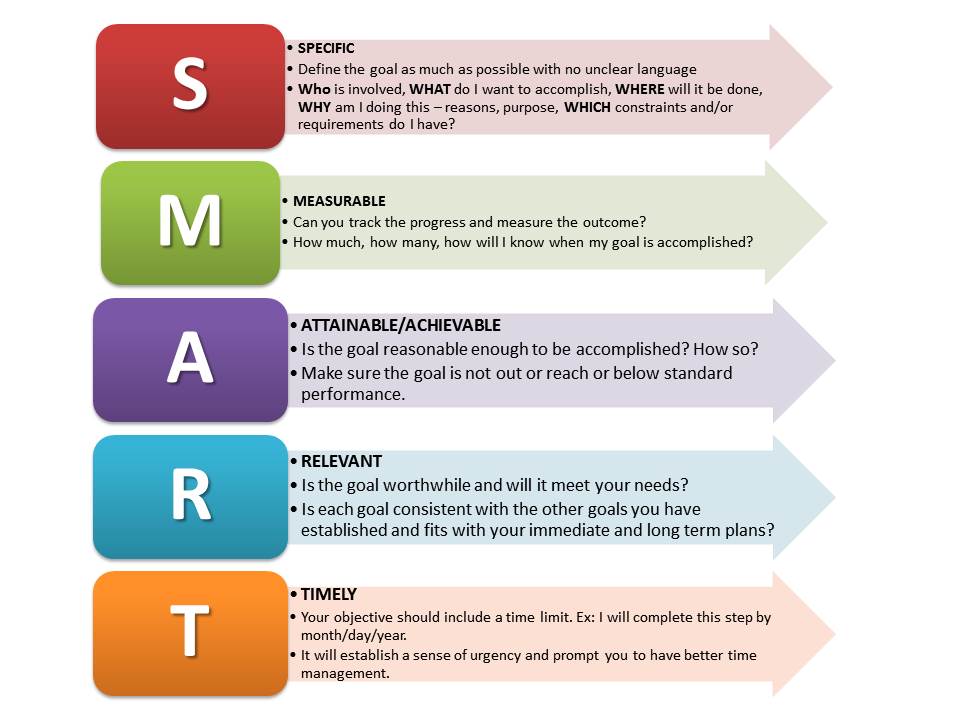
Source: House of Hunt
SMART goals, could look like this:
Till [Date] the [company]’s team in charge of content marketing will achieve [number]/ [metric] [interval].
Till March 30, 2022, Eagle Advertising’s team in charge of content marketing will reach 10.000 monthly new visitors for our blog.
Establish KPIs
The best approach on how to create a content marketing strategy that works is by using the right KPIs and contextualizing them with your brand. They must be aligned with your business goals, your strengths as a brand, and the life stage of your business.
They must also be tied to your company size because different businesses require different needs to meet the needs of a certain stage. For instance, if your business is fairly new, your content will be on creating awareness, so you should use KPIs that address this aspect and so on.
KPIs are important metrics that help you reveal the strong or weak points of your content marketing efforts (use a professionally executed content strategy template) that you should address in order to achieve your overall goals.
Such metrics show actionable insights such as:
Sales impact – B2B content marketing strategies zero down to which is the impact the content has on revenues. For this reason, you should develop effective systems for measuring sales impact across all your platforms.
Return on Ad Cost – Instead of doing a general calculation of revenue of the whole campaign over the ad spend, it’s best to take into consideration all the detailed cost factors e.g. the value of leads generated. Return on ad cost (ROAC) is the metric between return on investment (ROI) and return on ad spend (ROAS). The above-mentioned indicator offers you more insights into the effectiveness of the greater marketing budget and you will plan based on clear information and data.
Rate of voice in the market – how well do you connect with your audience? Do they consider you a voice that represents their views? This may be a difficult KPI to measure, but it can be pointed out in happy customers or audiences. Plus, if you have happy employees, then you’re winning at this.
Social impact – this is one of the content marketing strategy metrics that will contribute to your brand’s sustainable growth. This is because today people are all about better health and a better world. And what better way than meaningful content that adds so much value to social wellness? When your content adds to a positive social impact, then you’re on the right track.
Assess Current Position
The audit carried out should also show you your current market position. This is meant to answer the question of whether you’re achieving the goals you set for your brand. Some of the indicators of your market position include considering your content’s shelf life.
Is your content evergreen or has it been overtaken by time? It would be a good acid test for your efforts. You can also consider looking at cross-channel measurements. This means looking beyond impressions, organic traffic, or bounce rates. It means looking at whether your content feeds social platforms or whether it serves satisfactory customer service and so on. Does it offer more?
All these details will help you know your current state and where you need to tweak to get improved results.
Invest In Your Business
Your Content Strategy Doesn’t Deliver the Expected Results?
Pillar 3: Audience Research and Persona Development
Who are you trying to reach?
Your content is only as good as the leads and audience it attracts. You can draw thousands of views, but if only five of them are the right people who would use your product or services, it’s a waste of your team’s time.
Identifying who your content should be targeting will help your strategists to determine what types of topics, ideas, and keywords you should cover. What are the pain points of your audience and what is she interested in reading?
What characteristics should you identify about your audience?
Demographics: Age, gender, ethnicity, income, location, job title, etc.
Psychographics: Hobbies, interests, beliefs, habits, and more.
Challenges they face: What are they dealing with that would cause them to begin to search for your product or service?
Pain points: What in their life is causing a disruption or what problem does your product solve?
Where are they getting their information: If your audience is searching for a solution to their problems where are they turning to search for information?
What type of content do they prefer: What content format does your audience prefer to get the information they are looking for from?
How can we help: How can the content you create help, give your target audience the information they need?
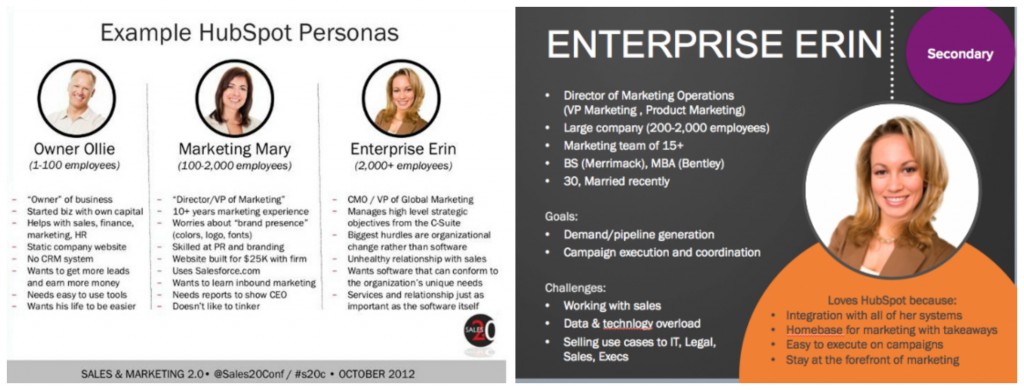
You may have several buyer personas profiles, so adjust the template accordingly.
Your ideal – primary buyer persona/primary audience – the persons you should focus on foremost because they have the highest probability to buy your products or services. The content you create should be targeted mainly at the primary buyer persona.
Your secondary buyer personas. These are people that accomplish most of the characteristics of the ideal audience but are not quite ready to buy. You need to convince them, attract them to a sales funnel and convert them into customers. For these secondary buyer personas, your content should be more strategic.
To find out this information about your buyer persona you may:
· Check your Google Analytics in the Audience section if you already have an established audience.
· Make a survey to find out. Tools like Survey Monkey or Google Forms can help you in your efforts.
Map the Customer Journey
Identifying your buyer persona is only the first step. The next critical step is mapping your customer journey. Your customer or audience journey map is just the chance for your business to stand out through the creation of the right content that responds to them in a way that they really need. The thing that most content marketing strategy templates miss by a huge distance is that your customers are at different stages of buying your products or services.
Customers don’t just zoom in from discovering to buying. They move from awareness to consideration, to the new customer stage (acquisition), and possibly all the way to the loyal customer stage. And all these stages require different content for your content marketing efforts to be effective. Feel free to check my marketing content strategy template to organize your content creation efforts around the buyer’s journey stages.
How can you achieve this? Here are a few key factors to consider:
i. Your Content Needs to Be Customer-Centric
Your content marketing strategies should be about offering your audience a great experience. And any improvement you create must be geared towards enhancing this experience.
This means you do not start designing your ideas about the product, but rather around what your customers need and how you can meet their needs. It’s about looking at your business from the customer’s lens. Don’t assume what they need. Find out while understanding their personas.
ii. Your Content Will Require Data
Mapping your customer journey will require data such as geographic locations, user downloads, or even cancellations. This will not only show you the customer stage, but it will also show you the products or content that is doing well and the ones that need improvement. It’s this data that you will use to create personalized content that helps your customers go the whole 9 yards of purchasing your products or services.
The 3 Main Stages of the Customer Journey
a. Awareness Stage
A potential buyer would gain from accessing content that would offer them solutions to issues they’ve been grappling with. They may not be ready to purchase yet, but your well-crafted quality relevant content is what will build awareness and guide them to the next stage.
The content for this stage should be about making their lives easier. Focus on topics that offer them the change they didn’t even know would be possible.
b. Consideration Stage
This content answers the question “why now”. It’s about retaining your customers’ interest in your products or services. To achieve this, your content must be able to win their trust and confidence. They must see that you get them. So, this means even the tone of your content must be reassuring for them to deeply consider what you’re offering and move on to the next stage.
c. Purchase Stage
This final stage is about creating content that removes all doubt about you. It answers the question “why you”. Why is your offer the best for this buyer? Create content that shines, and shows your uniqueness. Are you eco-friendly? Are you pro-health? What makes you superior? Create content that perfectly balances their very specific problems with your very specific solutions, and you will win hands down.
Pillar 4: Define the Content Pillars and the Subsequent Topics. Create the Content Calendar
The pillars of content or clusters of content are the skeleton of your content generation. The content pillars you create have to be related to the products and services you sell and respond to the questions, needs, pain points, and struggles of your audience related to them. Usually, by pillars of content, we understand the main topics or cornerstone topics that relate to your business. And they include a collection of subtopics that compose the pillar.
Let’s assume you have an SEO agency that provides SEO services for small and medium enterprises. Your main services are SEO-optimized content development, Link building, Local SEO, and Technical SEO.
Your content pillars might include:
– On-Page SEO
– Off-Page SEO
- Technical SEO
– Increasing traffic from organic sources
– Ranking Algorithms for major search engines
Each content pillar will have topics and types of content assigned.
Here is a content pillar example. A pillar of content like “Off-Page SEO” might include subtopics like:
– Top backlinking strategies
– How to successfully guest post
– Best practices to create an infographic
– Everything you need to know about Skyscraper strategy
Collaborate with your team to discover which of your client’s questions need to be answered. Speak directly with your clients, survey them or visit forums and questions and answers sites to find out.
My content marketing strategy template listed above includes a content pillar template to help you organize the topics in content clusters.
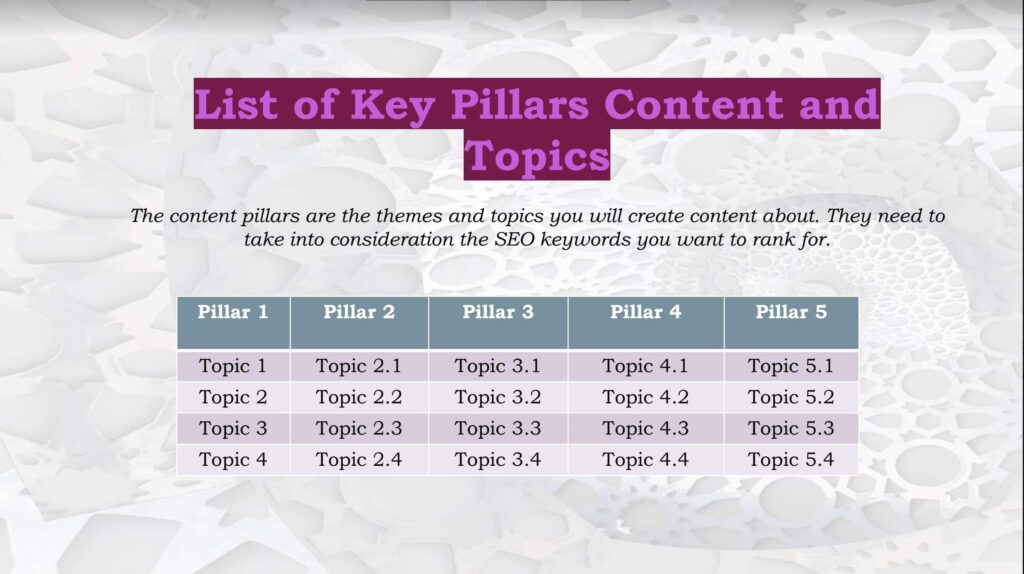
Identify the type of content you will produce
Nowadays, you can choose from a variety of types of content to attract your audience.
The content marketing world is a vast industry and goes far beyond the classical blog post, even if it is its foundation.
Among the types of content available you can pick:
* Articles and Blog Posts
* Videos
* Webinars
* eBooks
* Social Media Content
* Guides
* Reports
* White Papers
* Infographics
* Newsletters
* Case Studies
Pay attention to your audience preferences and align the types of content you produce with their interests and needs. If your audience is teenagers between 15 and 21, you should choose the video, if you target business professionals who prefer reading, ebooks might be the best choice for case studies.
Pillar 5: Create Design and Visual Content Standards
You need to create some design principles and standards to guide your designers while creating visuals for your brand. And your digital content marketing strategy is the place where you define it. Check the content strategy template to see. They are needed to grasp the message of your brand and translate it into coherent visuals and imagery.
Include the basic design elements like:
* Selection of fonts to use.
* Brand color combination.
* Logo-related requirements.
List here all the elements related to visual content that the marketing team should be aware of. Like dimensions of headings, quality of images to use, dimensions, and type of videos. Compulsory elements that should be present on each page, elements to totally exclude.
Consider using custom photos instead of stock to define your style. It will take effort and time, but in the end, it will be worth it.

Visuals are the first vector of sales.
Use Professional Styled Stock Photography to Promote Your Business.
Pillar 6: Identify the Channels to Promote Your Content
Deciding which channels you are going to use to promote your content is a task of major importance and you need to include them in your content calendar.
Always take into consideration being present when and where your audience hangs out.
The number one channel to consider is of course your own site, this is your main vehicle and one of the few that you own.
The second one is your mailing list. It’s overly stated that the mailing list is the most valuable asset of a business in our ever-changing digital era. You own your mailing list and on it, you have the most engaged persons with your business. If you decide to use your mailing list to promote your newly published content decide how many emails you are going to send and when.
Social Media is a sum of channels where you have to be present and promote your content. Choose and focus only on those social media platforms where your ideal client is present. You will not be able to present on all social networks, or you can but that will require huge efforts and resources are almost never enough. You have to pick among Facebook, Twitter, Pinterest, Instagram, Reddit, Medium, Snapchat, and more. So, pick wisely and based on analytics. I would suggest focusing on 2-3 maximum channels and on those to have a bold presence.
For instance, if you target B2B established professionals, LinkedIn is the best option, if your buyer persona is young people under 30, Snapchat or Instagram are better options to consider. Consider using analytics for each social media network to find the insights that you need. Test each potential platform to see which brings in the best results. Most probably you will face a trial and error process till you find the right channels for your business.
Once the social media channels are decided, the following step is to create a schedule to promote your content.
Each piece of content will religiously respect this schedule.
A promotion schedule on social media channels might look like this.
Day of publication:
One Pin on Pinterest
One Facebook post
One Instagram post
One week after publishing:
One LinkedIn repost
Two Tweets three times a week
One Medium repost
One Pin daily on group boards
Following weeks till one month after publishing:
One LinkedIn repost after one month of publishing
Two Tweets three times a week, four weeks after publishing
One repost weekly on Facebook
One Pin daily for one month in group boards and own relevant boards
Another option for your social media promotion is to use paid advertising. These ads help ensure your content gets seen and setting them up is incredibly easy.
Other channels where you want to guest post. Create a list of influencers in your niche or complementary niches that are to be contacted in order to guest post on their sites.
If you want to be featured in major publications like Forbes, Huffington Post, Wall Street Journal, Inc, Business Insider, or Entrepreneur include that here. Your best bet for contacting these influencers is with a personalized cold email.
To organize yourself better look for a content calendar template that can guide you with promotion channel selection.
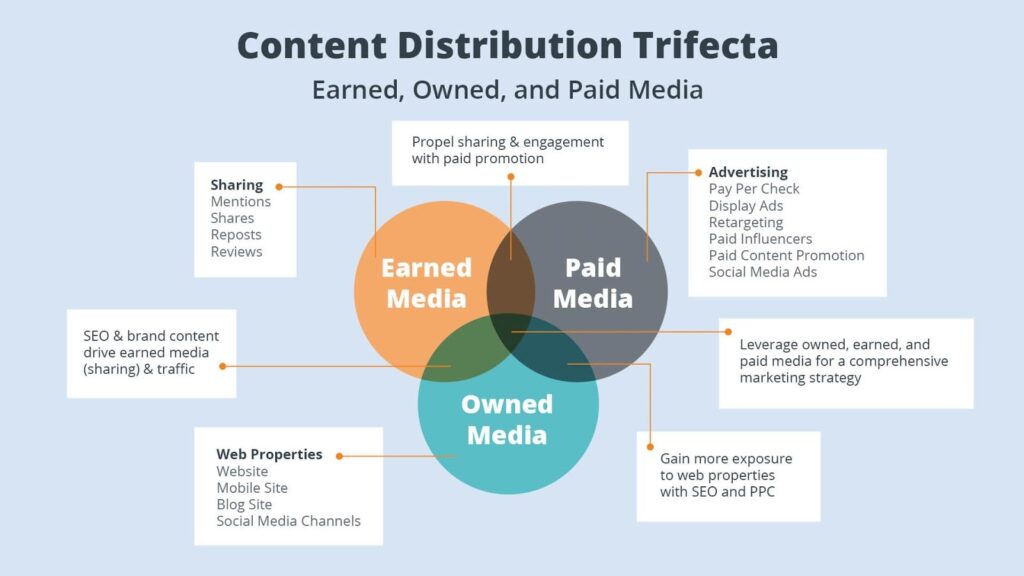
Pillar 7: Content Production Flow
After deciding what type of content you need to create, long form, short form, the next phase is the execution phase, literally creating that content. The preparatory element of creating content is designing the process of content creation: the steps that are to be covered, their order, and their length of time.
The content production process comprises all the phases till the piece of content passes to editors and designers.
The content generation process includes the creation and the editorial processes and explicitly indicates who does what, in which order, and when. The persons included in this activity are the content manager, the writers, the editors, the designers, and the SEO specialists.
The flow of the execution process includes all the tasks in chronological order.
In general, the content creation process includes:
· Brainstorming the topic for blog posts – 2-3 days, eventually establish a meeting with the team at the beginning of each trimester and decide on the topics for the period
· Assigning the publishing date and filling the publishing calendar – 1 day
· Researching other resources on the topic – 1 day
· Organizing interviews (if the case) or gathering data – 3-7 days depending on the type of piece of content
· Researching and establishing the keywords to be used for this topic – 1 day
· Creating the structure of the piece of content – outline – 2 days
· Revising and approving the outline – 1 day
· Crafting the first draft of the piece of content – 2-3 days depending on the length, for 1000 words article 1-2 days, for 20000-word ebooks 3-4 weeks
· Revising the draft – 1-4 days depending on the type of piece
· Sending to the editor – 1 day
Take into consideration the length of this process when deciding the date to start the writing process for each piece of content, in the function of the publishing date.
After the content is created it passes through the editorial process. The editorial process organizes the steps of preparing your content for publishing, the publishing itself, and the analysis of the result.
Here is an editorial process flow example:
Editing content – 1 – 4 days
Requesting revisions to be done by writers if the case – 1 – 2 days
Creating the design for the piece of content – 1 – 5 days
Approving the design – 1 day
Send the piece of content to the SEO specialist – in 2 – 4 days
Publishing content – 1 day
Set promotion campaign – 2 – 4 days
Approve and execute the promotion campaign – according to the calendar and promotion strategy
Post-publication analysis of results
Pick a Content Management System
An excellent content marketing strategy example must have a content management system because content marketing is most effective when the process can be repeated, optimized, and tracked. A CMS acts as a repository where your content lives, thereby helping you streamline and manage all your campaigns in one place. It also enables you to update your content across multiple channels, lets you repurpose the best content and so much more to facilitate your content production process.
Resource Allocation
What is a content marketing strategy without sufficient resource allocation? Having established a content calendar that includes important factors such as content type, platform to use, and the right audience, the next important thing is ensuring you have the necessary resources to help you deliver on your goals. This involves identifying the digital tools that you will need to produce your content, knowing who will be in charge of creating content items, and so on.
Depending on the size of the team you’re working with, you can identify the individual that will be in charge overall. If you outsource these services, then you will have to factor in these costs as well. You may for instance outsource a video specialist, freelancer, or graphic designer if you don’t have them in-house or if you are a start-up that doesn’t have a team yet.
Pillar 8: Editorial Calendar
Your content production process ends with the publication of the content your team created. These calendars are valuable tools as they allow your team to organize their tasks accordingly.
Calendars should include all the content types you plan to create and the following details:
· title of the article
· scheduled date of publication
· content pillar it belongs to
· funnel stage of the buyer journey – awareness stage or decision stage
· format of the piece of content – blog, infographic, ebook, long-form content, short-form, etc.
· channels of distribution – where the piece of content will be promoted – social media channels, other sites, etc
Having a defined editorial calendar, you’ll always have ideas of content ready to be created and in progress. The editorial calendar is one of the major parts of your website content marketing strategy. And will be of major help to be consistent with your publishing schedule and respect it. Publishing content consistently and regularly helps you gain authority and return visitors to your site.
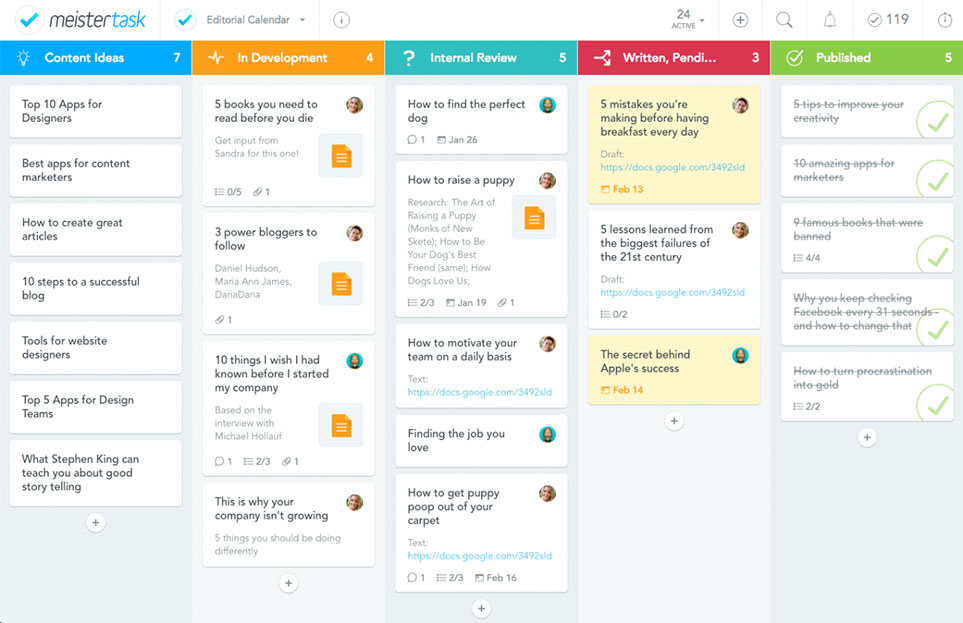
Source: Meistertask
Pillar 9: Measuring Results of Your Content Strategy
One of the major challenges of content marketers is to measure the success and results of the content created. Of course, lately, the situation has improved dramatically, we have now analytics, but has bounce rate an impact on your content’s success, are page views a huge indicator of success? Well, arguably.
Here are some metrics that you want to consider:
· pageviews. Many page views translate that you managed to attract the right audience interested in your content and products or that visitors were searching for more information on a certain subject
· time-on-page. The longer the better. High dwelling time means the content was considered useful by the readers if it was long enough, for a short text might mean that it is difficult to consume, and readers spend much time depicting it.
· social shares. The more the better, as usual. Even if that will not necessarily translate into more business for you, it is certainly an indicator of success.
· bounce rate. A small bounce rate, well that’s another discussion: what do we consider a “small bounce rate”, means that the audience is interested in your content. And reverse a high bounce rate, which means that the audience was not interested. Though, it is not necessarily an indicator of the quality of your content. If your content ended up in front of the wrong audience, that’s just to be expected. If I end up on a blog about food for cats and I am not a cat lover, my visit will be a bounce rate.
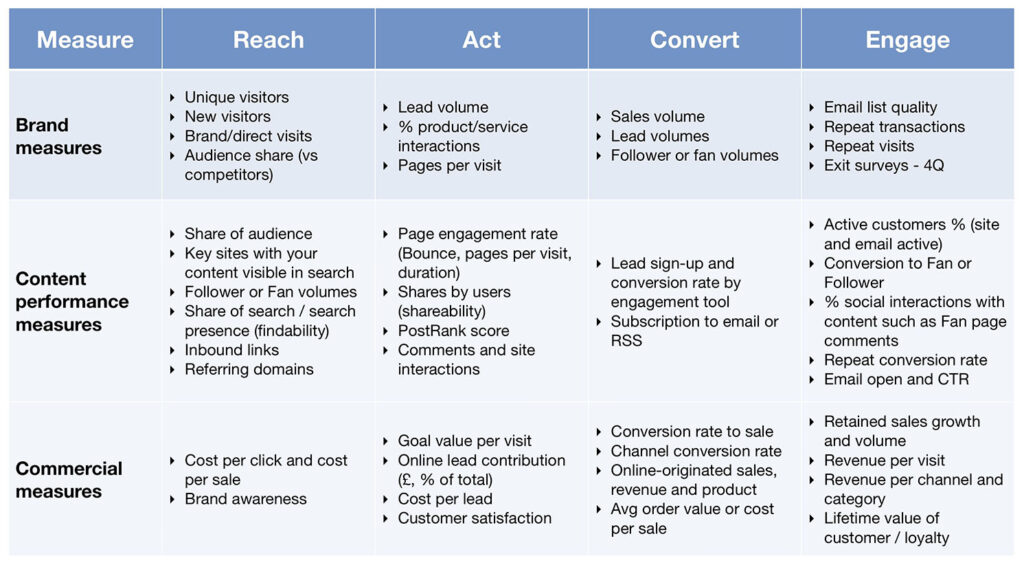
Experience with your own content will learn you and your team how to identify problems and how to solve them.
After deciding what your measurement process will look like and which indicators will be used, you should also decide how often you will create the reports and establish some templates for these reports. It will be easier to conclude if you use a uniform template for the reports that will ease the comparison of metrics.
Pillar 10: Define Your Content Strategy Budget
All marketing activities involve a budget. When creating your content strategy, you need to have at least an approximate idea of how much it will cost to implement it. If you have the internal resources to execute it, or you need to hire help in-house or external consultant experts.
Determine how much it will cost to produce the content that you established in the strategy, how much it will cost to promote it, and if you are going to use paid channels how much budget you want to spend for this purpose.
There you have it, the 10 major pillars that sustain a successful content marketing strategy able to support your future growth and expansion.
How to create a content marketing strategy?
- Do a content audit.
Inventorize your existing content, do an audit for all your articles, a competitor analysis, and identify the content gap for your semantic keywords.
- Define your content goals.
Pay attention to setting some S.M.A.R.T. (specific, measurable, attainable, relevant, timely) goals. Assess the current situation and establish KPIs.
- Audience research, persona development, and buyer journey definition.
Define your buyer persona (ideal customer) and her characteristics. Identify which are the steps that a potential client takes to become a customer.
- Define the Content Pillars and the Subsequent Topics. Create the Content Calendar.
Identify the main content clusters and information that your client needs to solve his problems with your products/services. Or what subject to write about to attract your audience.
- Create Design and Visual Content Standards.
Establish what principles and conditions are to be accomplished to create a cohesive brand.
- Identify the Channels to Promote Your Content.
Where will you publish your content on your own site, on your social media channels, on tier channels, etc?
- Content Production Flow.
Put in place a procedure to be followed when creating content.
- Editorial Calendar.
Organize the identified topics in an editorial calendar with all the details, date of publication, format, stage of the journey, content pillar, and distribution channels.
- Measure the results of your content strategy
Measure the established KPIs and see which are the results obtained and what is needed to improve them.
- Determine your content strategy budget
Estimate a price for each activity included in the strategy and determine the budget needed to implement your strategy.
